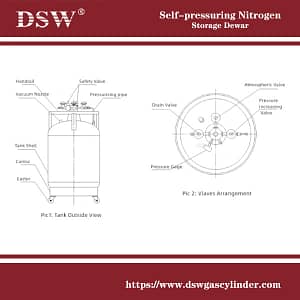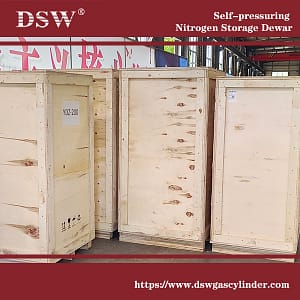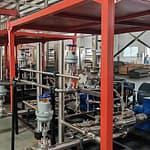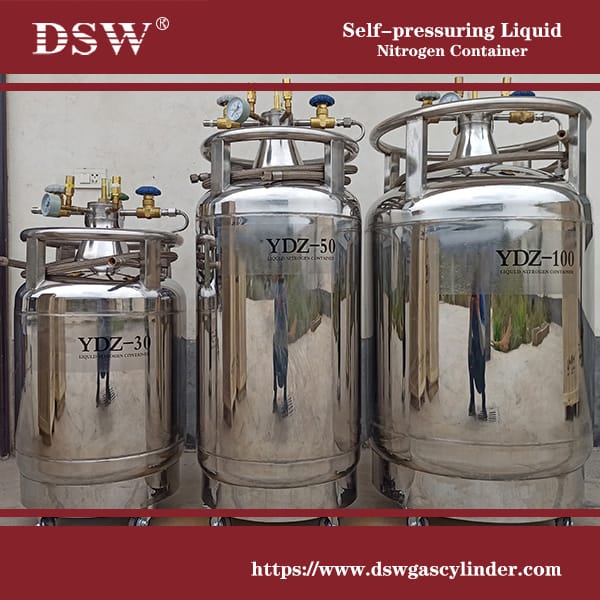self-pressurized liquid nitrogen containers
DSW offers a variety of liquid nitrogen storage equipment, including self-pressurized liquid nitrogen containers, benchtop LN2 containers, and pressurized stainless-steel LN2 supply tanks.
Our liquid nitrogen containers are widely used in animal husbandry, medical treatment, research, industry, and other departments.
They are also excellent tools for storing, transporting, and supplementing liquid Nitrogen.

What are self-pressurized containers?
Self-pressurized liquid nitrogen containers are designed to store and transport liquid nitrogen.
They are equipped with a self-pressurizing mechanism that uses the pressure from vaporizing a small amount of liquid Nitrogen to discharge LN2 into other containers.
The storage capacities of these containers range from 5 to 500 litres.
Structure Diagram

The main features of LN2 container
1. Convenient filling of liquid Nitrogen:
Just unscrew the screw plug of the liquid nitrogen injection port. The fluid discharge port or pipeline of the fractionation tower of the liquid nitrogen machine can be used.
When the screw plug is installed with a level gauge, the discharge port can be used as the inlet port for liquid nitrogen filling.
2. The container adopts the pressurization method of pressure on the tank after a small amount of liquid nitrogen gasification, which is convenient to operate and fast to pressurize, ensuring liquid Nitrogen’s purity.
3. High container strength, suitable for short-distance transportation.
4. The discharge pressure of the container is extremely low, and the pressure gauge, safety valve, and vacuum sealing joint are installed. Therefore, the container is safe and reliable in use.
5. Shell, liner, and main parts are made of austenitic 304 stainless steel, with good vacuum and low-temperature performance.

1. Tank: used to hold liquid Nitrogen.
2. Screw plug: the seal of the liquid nitrogen injection port is connected with thread and equipped with a low-temperature resistant PTFE sealing ring to prevent nitrogen leakage and decompression.
3. Liquid level gauge: display the liquid Nitrogen level in the tank. (This item is optional, with a liquid level gauge, a screw plug is not available)
4. Vent valve: according to the need to release air and decompress. When spinning out the screw plug of the liquid nitrogen injection port, the discharge valve must be opened first to remove air and relieve pressure. Open the valve when the container is not in use.
5. Turbocharging valve: when opened, it can make the inner pressure rise and should be closed tightly when not used.
6. Pressure gauge: used to indicate the size of the tank pressure.
7. Safety valve: Control the inner pressure under the highest working pressure. Once the internal pressure exceeds the most increased working pressure, it will automatically open, providing exhaust pressure relief.
8. Vacuum sealing joint: It is the suction port of the vacuum interlayer in container manufacturing. It has the effect of vacuum pumping. In addition to one and the inner liner leakage, the interlayer produces internal pressure, and the inner liner and shell play a protective role of pressure relief.
9. Caster wheel: used to support the whole liquid nitrogen container and facilitate the container to move.














